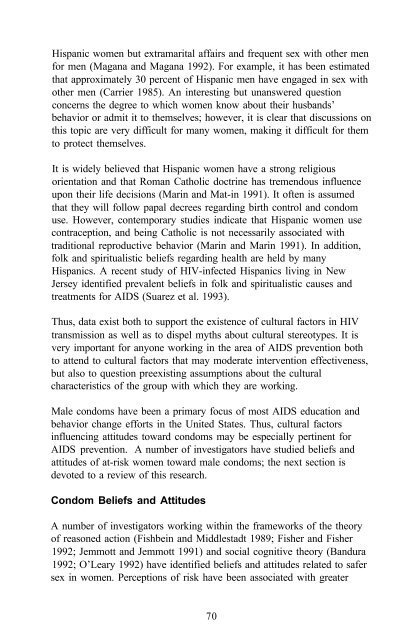The Context of HIV Risk Among Drug Users and Their Sexual Partners
The Context of HIV Risk Among Drug Users and Their Sexual Partners
The Context of HIV Risk Among Drug Users and Their Sexual Partners
Create successful ePaper yourself
Turn your PDF publications into a flip-book with our unique Google optimized e-Paper software.
Hispanic women but extramarital affairs <strong>and</strong> frequent sex with other men<br />
for men (Magana <strong>and</strong> Magana 1992). For example, it has been estimated<br />
that approximately 30 percent <strong>of</strong> Hispanic men have engaged in sex with<br />
other men (Carrier 1985). An interesting but unanswered question<br />
concerns the degree to which women know about their husb<strong>and</strong>s’<br />
behavior or admit it to themselves; however, it is clear that discussions on<br />
this topic are very difficult for many women, making it difficult for them<br />
to protect themselves.<br />
It is widely believed that Hispanic women have a strong religious<br />
orientation <strong>and</strong> that Roman Catholic doctrine has tremendous influence<br />
upon their life decisions (Marin <strong>and</strong> Mat-in 1991). It <strong>of</strong>ten is assumed<br />
that they will follow papal decrees regarding birth control <strong>and</strong> condom<br />
use. However, contemporary studies indicate that Hispanic women use<br />
contraception, <strong>and</strong> being Catholic is not necessarily associated with<br />
traditional reproductive behavior (Marin <strong>and</strong> Marin 1991). In addition,<br />
folk <strong>and</strong> spiritualistic beliefs regarding health are held by many<br />
Hispanics. A recent study <strong>of</strong> <strong>HIV</strong>-infected Hispanics living in New<br />
Jersey identified prevalent beliefs in folk <strong>and</strong> spiritualistic causes <strong>and</strong><br />
treatments for AIDS (Suarez et al. 1993).<br />
Thus, data exist both to support the existence <strong>of</strong> cultural factors in <strong>HIV</strong><br />
transmission as well as to dispel myths about cultural stereotypes. It is<br />
very important for anyone working in the area <strong>of</strong> AIDS prevention both<br />
to attend to cultural factors that may moderate intervention effectiveness,<br />
but also to question preexisting assumptions about the cultural<br />
characteristics <strong>of</strong> the group with which they are working.<br />
Male condoms have been a primary focus <strong>of</strong> most AIDS education <strong>and</strong><br />
behavior change efforts in the United States. Thus, cultural factors<br />
influencing attitudes toward condoms may be especially pertinent for<br />
AIDS prevention. A number <strong>of</strong> investigators have studied beliefs <strong>and</strong><br />
attitudes <strong>of</strong> at-risk women toward male condoms; the next section is<br />
devoted to a review <strong>of</strong> this research.<br />
Condom Beliefs <strong>and</strong> Attitudes<br />
A number <strong>of</strong> investigators working within the frameworks <strong>of</strong> the theory<br />
<strong>of</strong> reasoned action (Fishbein <strong>and</strong> Middlestadt 1989; Fisher <strong>and</strong> Fisher<br />
1992; Jemmott <strong>and</strong> Jemmott 1991) <strong>and</strong> social cognitive theory (B<strong>and</strong>ura<br />
1992; O’Leary 1992) have identified beliefs <strong>and</strong> attitudes related to safer<br />
sex in women. Perceptions <strong>of</strong> risk have been associated with greater<br />
70
















